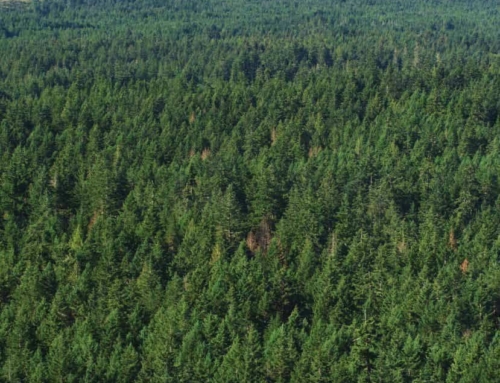How can a mill surrounded by forest run out of logs unless they’re being exported?
All BC mills are set-up to process a specific kind of log—such as 9-12 inch diameter Douglas fir or 20-40 inch diameter cedar. But our forests grow a real mix of trees—from high value Douglas fir and cedar to lower value hemlock and balsam and a lot in between. This means that logs harvested near mills don’t always fit local mills’ needs, and the economic feasibility for transporting logs from other locations to those mills may not make sense.
If we didn’t export these logs to China, wouldn’t someone build a mill here to process them?
There are mills and manufacturing facilities on BC’s coast. In fact, the majority (65%) of logs harvested on BC’s coast are processed in BC. (When we include the Interior, that number rises to 90%.) The forest industry is full of entrepreneurs. If it became financially worthwhile to a build new mill, someone would build one. In fact, there’s a mill opening in Surrey right now that will be trying to make today’s challenging environment profitable.
Why don’t we send logs to the Interior to be milled since they have a log shortage?
Some coastal logs being exported today meet the requirements for BC’s Interior mills. So really, it comes down to economics. The transportation cost required to ship the logs from the coast to the Interior in most cases does not make economic sense. There are some mills in towns near the coast (Kamloops, Princeton and Merritt) that have brought logs out of the eastern Fraser Valley for many years. However, as you move further north or west, the economics of hauling logs makes it more difficult to be profitable.
Can any log be exported?
Yes. However, there are tight restrictions on BC’s highest quality logs (A,B,C,D,E,F and G grade), as well as for all cedar and yellow cedar grown on provincially regulated land. Why specify provincial Crown land? Cedar grown on federally regulated land (i.e., private timberlands and First Nations reservations) can be exported; however, that volume is negligible on a provincial scale.
How can you say log exports support local jobs in the forest?
Our forests grow a real mix of trees. A typical forest where we harvest could have 30% mixed value Douglas Fir, 30% high value cedar, 30% low value hemlock and balsam, and 10% other species. With that kind of mix, having an export market for low value logs makes it easier to be profitable throughout the whole cutblock. If a timber harvester is unable to export the lower value logs and there is no demand from our local manufacturer, those trees may not be harvested at all. If those trees aren’t harvested, it can make it uneconomical to harvest the area at all. Given the mix of trees species and quality in coastal BC, having access to log export markets gives timber harvesters flexibility.
If a BC mill needs logs, do they have a way to get them?
Yes, the surplus test mechanism allows any domestic manufacturing company to put an offer on or “block” logs trying to be exported. So domestic mills can stop any logs from being exported. Typically some sort of arrangement for meeting the needs of the local mills is made without resorting to “blocking.” It is a fine balance. Domestic mills do have the ultimate say; however, the exporter does not have to sell the “blocked” logs to the mill that blocked them. The surplus test mechanism simply ensures the logs are sold within BC.
Why then do small and independent manufacturers say they can’t get enough logs to feed their mills?
This is a problem and we think it is related to control of the timber resource. As a province, we need to address the consolidated control of tenure in BC and make sure small and independent manufacturers have greater access to this public resource. We published an article about this issue in the Fall 2016 issue of Truck LoggerBC, “Fibre, Fibre Everywhere, But Not A Log To Mill.”
So many mills have closed on BC’s coast. If log exports aren’t the problem, what is?
As discussed above, one issue is the economic climate on the coast is not conducive to supporting those mills. An important factor is the price of the products we produce for international markets. If that market price is not high enough to cover the costs of making that product, that manufacturer will close. It’s also worth noting that new, modern mills use a lot more computers and robots and, as a result, employ a lot less people than older mills. So a new mill doesn’t generate the level of employment an old mill used to.
Another factor is our shrinking working forest. The allowable annual cut (AAC) has fallen from a high of 24.5 million cubic metres in 1985 to 16.5 million cubic metres today, a reduction of 8 million cubic metres or 33 per cent. This is primarily as a result of increased environmental protection that reduced the size of the coastal working forest. Given the average capacity of the current mills operating on the coast, 8 million cubic metres equates to 16 sawmills closed. Coastal sawmills and pulp mills have closed, in part, as a result of significant AAC reductions as British Columbians work to find a balance between environmental protection and a healthy forest industry. We published an article about this issue in the Spring 2017 issue of Truck LoggerBC, “Log Exports: The Story Behind The Story.”







Get Social